
Sparaxis is a genus of flowering plants called the harlequin flowers. It belongs to the iris family Iridaceae with about 13 species endemic to Cape Province, South Africa.

Dioscorea bulbifera is a species of true yam in the yam family, Dioscoreaceae. It is native to Africa, Asia and northern Australia. It is widely cultivated and has become naturalized in many regions.

Cystopteris is a genus of ferns in the family Cystopteridaceae. These are known generally as bladderferns or fragile ferns. They are found in temperate areas worldwide. This is a very diverse genus and within a species individuals can look quite different, especially in harsh environments where they experience stress and remain small and stunted. Also, they hybridize easily with each other. Identifying an individual can be challenging. In general these are rhizomatous perennials which may grow in rocky areas or in soil. Their leaves are multiply pinnate, in that each leaflet is divided into smaller parts. The sori are usually rounded and are covered in an inflated bladder-like indusium.

Cystopteris bulbifera, with the common name bulblet fern, bulblet bladderfern, or bulblet fragile fern is a fern in the family Cystopteridaceae.

Sparaxis bulbifera, commonly known as harlequin flower, is a bulb-forming perennial plant. The species is native to Cape Province in South Africa and naturalised in the Azores and Australia. It grows to between 15 and 60 cm high and has white to cream flowers.

Cicuta bulbifera, commonly known as the bulb-bearing water-hemlock, is a plant native to North America and one of four species in the poisonous genus Cicuta. Tiny bulbils form in the leaf joints in the upper part of the plant, giving the plant its scientific and common names. Cicuta bulbifera can be distinguished from Cicuta douglasii by its narrow leaflet segments and its bulbil-bearing upper leaf axils.

Lachenalia bulbifera, syn. L. pendula, is a species of flowering plant in the family Asparagaceae, native to the Western Cape of South Africa. It is a bulbous perennial growing to 30 cm (12 in) tall by 5 cm (2 in) broad, with strap-shaped spotted leaves and fleshy stems bearing pendent tubular orange or red flowers 3 cm long, in winter and spring. The Latin bulbifera literally means "bulb-bearing", and refers to the plant's habit of producing bulblets, which can be separated from the parent plant and grown on.
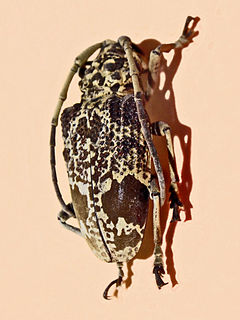
Phryneta is a genus of flat-faced longhorn beetles belonging to the family Cerambycidae.

Phrynetini is a tribe of longhorn beetles of the subfamily Lamiinae. It was described by Thomson in 1864.

The Castilloa Borer is a species of beetle in the family Cerambycidae. It was described by Johan Christian Fabricius in 1775, originally under the genus Lamia. It has a wide distribution throughout Africa. It feeds on Morus alba, Hevea brasiliensis, Coffea arabica, and Chlorophora excelsa.

Phryneta aurocincta is a species of beetle in the family Cerambycidae. It was described by Félix Édouard Guérin-Méneville in 1832, originally under the genus Lamia. It has a wide distribution throughout Africa.
Phryneta coeca is a species of beetle in the family Cerambycidae. It was described by Chevrolat in 1857. It is known from Tanzania, the Central African Republic, the Ivory Coast, Cameroon, the Democratic Republic of the Congo, and Togo.
Phryneta conradti is a species of beetle in the family Cerambycidae. It was described by Hermann Julius Kolbe in 1894. It is known from the Democratic Republic of the Congo, Tanzania and Malawi.
Phryneta ellioti is a species of beetle in the family Cerambycidae. It was described by Charles Joseph Gahan in 1909. It is known from Uganda and the Democratic Republic of the Congo.
Phryneta ephippiata is a species of beetle in the family Cerambycidae. It was described by Francis Polkinghorne Pascoe in 1864. It is known from South Africa and Namibia.
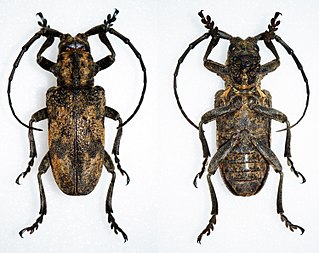
Phryneta obesa is a species of beetle in the family Cerambycidae. It was described by Westwood in 1845. It has a wide distribution in Africa.
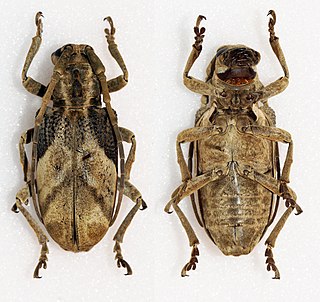
Phryneta semirasa is a species of beetle in the family Cerambycidae. It was described by Dohrn in 1885. It is known from Tanzania, the Democratic Republic of the Congo, Mozambique, Zimbabwe, Malawi, and Zambia.
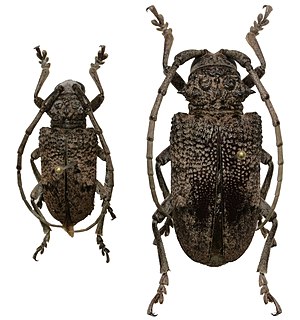
The Fig-tree Borer Longhorn Beetle, or Fig Tree Borer, is a species of beetle in the family Cerambycidae. It was described by Johan Christian Fabricius in 1792, originally under the genus Lamia. It has a wide distribution throughout Africa. It feeds on Pyrus communis, Ficus carica, Salix babylonica, Cupressus sempervirens, and Vitis vinifera.

Phryneta verrucosa is a species of beetle in the family Cerambycidae. It was described by Dru Drury in 1773, originally under the genus Cerambyx. It is known from Equatorial Guinea, and was introduced into Barbados, Grenada, and Trinidad and Tobago.
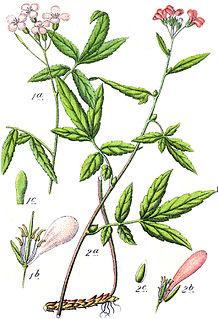
Cardamine bulbifera, known as coralroot, is a species of flowering plant in the family Brassicaceae. It is a perennial with upright, mostly unbranched, stems to 70 cm (28 in) tall, and leaves made up of between three and 13 leaflets. The flowers have petals that are 10–15 mm (0.4–0.6 in) long collected in corymbose few-flowered racemes and are generally light purple, pink or almost white. It is found in damp places.














